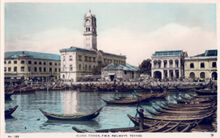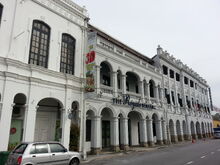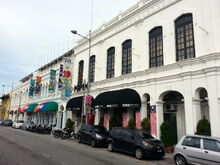
Weld Quay, which runs along the eastern coast of George Town, is also home to several colonial-era buildings, warehouses, piers and a Rapid Penang bus terminal.
Weld Quay, in the heart of George Town's UNESCO World Heritage Site, is a coastal road that runs along the eastern coast of the city centre. It continues on as Tun Dr. Lim Chong Eu Expressway to the south and terminates at the Light Street Roundabout to the north. Some of the major transportation hubs in the city are located here, such as Swettenham Pier, the Ferry and Bus Terminals, and even a now-defunct train station, as well as the historic Clan Jetties.
The road was created in the 1880s following a massive land reclamation. Following the reclamation of the area, a number of piers and warehouses were built along the new shoreline to allow for harbour trade activities. The Chinese coolies working at the Port of Penang also established their own living quarters - the Clan Jetties. Today, the most famous of all the Clan Jetties is the Chew Jetty.

A Weld Quay sign
With the loss of Penang Island's free port status in 1969 and the relocation of the Port of Penang's cargo operations to the mainland, the piers along Weld Quay now cater to human passengers. Swettenham Pier remains a popular berthing destination for cruise ships, while Ferry users alight at the Ferry Terminal with the option of boarding the Rapid Penang buses at the Bus Terminal nearby.

View of Weld Quay, facing south towards Tun Dr. Lim Chong Eu Expressway
Etymology[]
Weld Quay was named after Sir Frederick Aloysius Weld, the Governor of the Straits Settlements between 1880 and 1887, at the time when the land reclamation was being carried out.
Weld Quay is also known as Kitengi Teru in Tamil, which means 'warehouse street', in reference to the warehouses that line the road. Meanwhile, the Hokkiens call the street Cun3 Thau2, which simply means the harbour.

A 1900s postcard depicting Weld Quay, George Town. The Malayan Railway Building, the tallest structure in this postcard, remains the most imposing colonial building along the road to this day.
History[]
Weld Quay was created as part of a massive land reclamation project between 1883 and 1889, which ultimately cost $526,107 (Straits Dollar). The land reclamation was intended to provide a deeper Port of Penang, which was then entirely based in George Town, as well as creating more space for harbour trade. Prior to the land reclamation, the sea reached all the way up to Beach Street.

The Malayan Railway Building now houses the Royal Malaysian Customs' Penang headquarters.
Upon the completion of the reclamation works, new facilities, such as warehouses and piers, were built. Church Street Pier was built in 1897 for smaller vessels such as ferries, while the Malayan Railway Building across the street was completed in 1909. In the olden days, the islanders could purchase train tickets for their train journey on mainland Malay Peninsula, and then board a ferry at Church Street Pier to Butterworth to take the train. Meanwhile, ferry passengers who wished to travel with their vehicles were directed to Victoria Pier, which once existed off Downing Street.

Church Street Pier in the 1930s
To the north, Swettenham Pier, then known as Iron Pier, was completed in 1904, turning George Town into a modern transshipment centre. Three years later, the government-owned goods sheds were opened for lease by shipping agents.

The eastern coast of George Town, as seen from Chew Jetty.
To the south, the Chinese who were employed by the Port of Penang also created the Clan Jetties as their waterfront living quarters. The jetties were divided by clan names, resulting in six different settlements - Lim, Chew, Tan, Yeoh, Lee and the Mixed Clan Jetties. The latter jetty catered to those of other surnames. Interestingly, each surname specialised in certain businesses; for instance, the Lims, Chews and Lees worked as boatmen, stevedores and harbour coolies, while the Tans, Yeohs and Koays focused on firewood and charcoal making.

Abandoned warehouses along Weld Quay
The Indians were also involved in the harbour trading activities as coolies. Notably, two Indian Muslim clans - the Rawther and the Maraicar - became the main contractors for Indian coolies, at a time when shipping was a labour intensive industry.

Wisma Yeap Chor Ee, one of the colonial office buildings at Weld Quay
As a result of the booming entrepot trade between the late 19th century and the 1960s, which made the Port of Penang one of the most vital harbours within Malaya at the time, colonial buildings were erected along the northern section of Weld Quay (north of the junction with China Street Ghaut). These buildings once housed the offices of European and Chinese merchants due to their strategic locations adjacent to the Port of Penang.
Today, Weld Quay is a shadow of its former, bustling self. Penang Island's free port status was revoked in 1969, while the Port of Penang eventually relocated its cargo services to Butterworth in the 1970s. For a time, Weld Quay became derelict as a result of the dearth of economic opportunities. In recent years, however, more attractions have been added along Weld Quay, such as galleries and museums. The Penang state government, in collaboration with corporate parties such as Think City, has also drawn up plans for the renewal of the Weld Quay waterfront, possibly by creating public space for recreational and retail activities.

Church Street Pier today
Under the Penang Transport Master Plan, a proposed tram system within the UNESCO World Heritage Site will also include two stops along Weld Quay - Ferry Terminal and Swettenham Pier.

The Schmidt Küstermann Building, one of the several colonial buildings along Weld Quay. It houses the Royale Bintang Hotel.
Notable Landmarks[]

Behn Meyer Building, another colonial building at Weld Quay, now houses the Made in Penang Interactive Museum.
From north to south :
- Swettenham Pier
- Penang General Post Office
- Boustead Building
- Schmidt Küstermann Building
- Behn Meyer Building
- Schiffman Herr Building
- Behr Building
- Church Street Pier
- Tanjung City Marina (defunct)
- Paterson Simons Building
- Rice Miller Hotel
- Malayan Railway Building
- Wisma Yeap Chor Ee
- Weld Quay Bus and Ferry Terminals
- Clan Jetties

The Schiffman Herr Building now houses the Penang Amazing World Studios.
Museums and Galleries[]
The most popular museum at Weld Quay is arguably the Made in Penang Interactive Museum, which is housed within the Behn Meyer Building. The museum actually showcases 3D interactive art and dioramas that depicts Penang's culture, local customs and lifestyles.
Two other galleries have been opened more recently along Weld Quay - Penang Amazing World Studios and Penang Science Cluster. The former, within the Schiffman Herr Building, is an interactive photo studio, while the latter, inside Wisma Yeap Chor Ee, is a cafe-cum-gallery exhibiting scientific and technological innovations.
Transportation[]
As Weld Quay was originally created as the site of the Port of Penang, a number of piers were built along the road.

Swettenham Pier, at the northeastern tip of George Town, now caters to cruise ships.
Today, only Swettenham Pier remains fully operational, serving as a popular berthing destination for cruise ships. In fact, Swettenham Pier is one of the major entry points into Penang apart from the Penang International Airport and the overland links; Swettenham Pier recorded 1.2 million arrivals in 2014 and attracted some of the world's largest cruise liners, such as the RMS Queen Mary 2. In addition, Swettenham Pier is the home port of a handful of cruise ships, providing cruise services to other popular destinations within South-East Asia, including Singapore and Phuket.

The Weld Quay Bus Terminal is the main terminus for Rapid Penang public buses within Penang Island.
Further south along the road, sits the Ferry and Bus Terminals. The Pengkalan Raja Uda Ferry Terminal serves passengers boarding and alighting from one of the Penang Ferries that ply the Penang Straits between George Town and Butterworth on mainland Malay Peninsula. Ferry passengers could also conveniently board Rapid Penang public buses to anywhere within Penang Island.
Hotels[]
- Royale Bintang (Schmidt Küstermann Building and Boustead Building)
- Rice Miller
- My Chew Jetty Vacation Home
Political Representation[]
Penang State Government[]
Northern stretch between Light Street and China Street :
N.26 Padang Kota State Assemblyman : Chow Kon Yeow (Democratic Action Party)
Southern stretch between China Street and Tun Dr. Lim Chong Eu Expressway :
N.27 Pengkalan Kota State Assemblyman : Lau Keng Ee (Democratic Action Party)
Malaysian Federal Parliament[]
P.049 Tanjong Member of Parliament : Ng Wei Aik (Democratic Action Party)
References[]
- Khoo S.N., 2007. Streets of George Town, Penang. Areca Books, Penang.
- http://www.penang-traveltips.com/weld-quay.htm
- http://www.tourismpenang.net.my/index.php/Living-Heritage-Traditional-Trades/the-weld-quay-clan-jetties-water-settlement
- http://penangmonthly.com/where-the-sea-meets-the-city-is-where-the-world-meets-penang/
- http://penangmonthly.com/is-penangs-tourism-on-the-right-track/
- http://penangmonthly.com/the-changing-harbour-front/